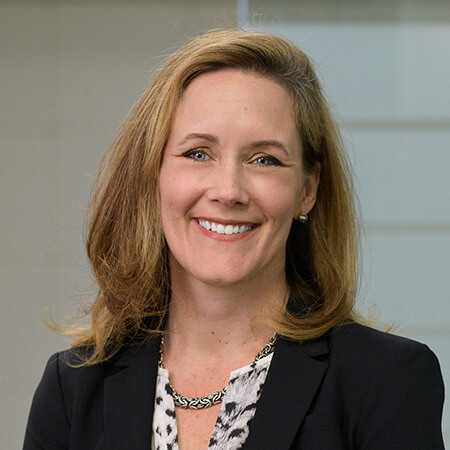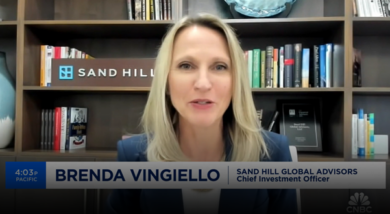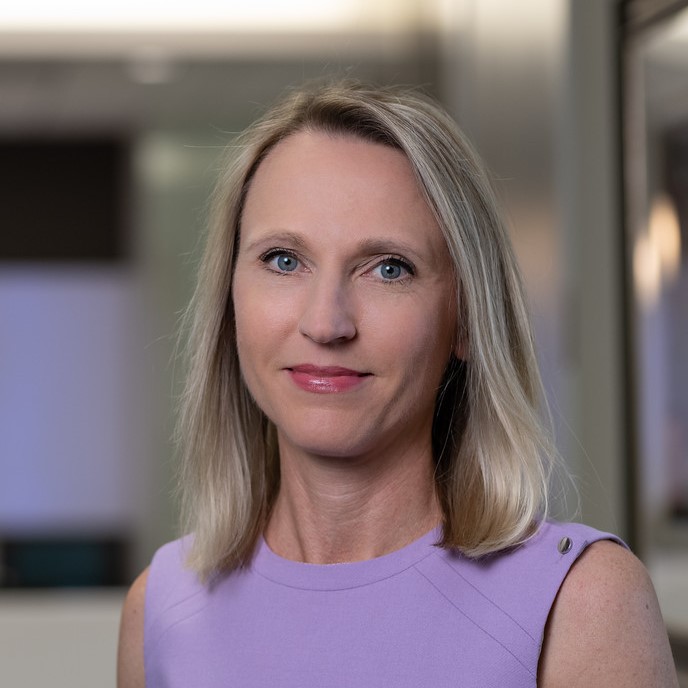Brenda Vingiello, Sand Hill's Chief Investment Officer, joined the Halftime Report to discuss the software space. This content was produced and provided by an unaffiliated

The Reality of Investment Risk
August 24, 2020
Below is a transcript of the video interview.
Sara Craven:
Welcome, everyone, to another episode of the Sand Hill interview series, where we discuss the science and art of navigating complex wealth. In this series, we speak with subject matter experts and thought leaders around all things pertaining to managing and dealing with complex wealth strategies. I am Sara Craven, Chief Wealth Manager at Sand Hill, and in today’s episode, I’ll be interviewing Sand Hill’s own CEO, Brian Dombkowski. In our discussion today, we’ll be discussing these three things: why do advisors care about your risk tolerance? How do you assess your risk tolerance during periods of market volatility? And what are the types of risks that our audience should be aware of? So, Brian, thank you for joining me in today’s discussion.
Brian Dombkowski:
Thank you, Sara. It’s certainly a pleasure to be here.
Sara Craven:
Thank you. So with that, let’s jump right in, and let’s start with the basics. Why is it important to understand your risk tolerance?
Brian Dombkowski:
Sure. So, the reason we spend a lot of time assessing someone’s ability to tolerate risk is that doing so is one of the fundamental underpinnings of a well-designed portfolio. Typically, that assessment involves answering a series of questions related to your financial position, investment goals, and your attitudes towards maintaining a consistent portfolio even through periods of significant volatility. The objective is to reveal where you reside on that risk spectrum, ranging from conservative to aggressive. One size doesn’t fit all, and we need to be able to build a portfolio that is suitable for your needs, which can allow you to stick to your financial plan even when the going gets rough.
Sara Craven:
That’s a lot to expect from just a questionnaire.
Brian Dombkowski:
Well, that’s true, but we also need to understand what we call your empirical risks, or observable behaviors in your life, as well as a number of other variables that will influence and predict your ability to reap the rewards that are possible for the long-term, patient investor. The bottom line is, there are a lot of risks in the marketplace that you need to manage through, so understanding those risks and your risk tolerance is a very important first step.
Sara Craven:
On that note, for anyone interested in assessing their own risk tolerance, please click below to ask for your own preliminary risk application. Now, you mentioned there are a lot of risks out there. What are some of the general types of risks our viewers should be aware of?
Brian Dombkowski:
Well, there are many types of conventional risks that investors should be aware of, including the primary risk of investments declining in value because of economic developments or other events, as we’ve seen, that affect the entire market. But beyond that obvious risk, there are a series of other exposure risks that can be addressed by constructing a well-diversified portfolio, properly thinking about stock concentrations in that portfolio, minimizing the use of leverage, and incorporating outside investments, as well as your overall exposure to real estate, private investments, and even artwork. At Sand Hill, we consider your entire personal balance sheet when we recommend how your investible assets should be deployed so that these assets can complement each other. But as I mentioned prior, one of the biggest risks is the one that we all bring with us, and that is the behavioral finance piece, the idea that investing… With that comes emotion, and that emotion, if it’s left unchecked, can result in people making the wrong decisions at the wrong time.
Sara Craven:
Like the one we just went through.
Brian Dombkowski:
Yeah, well, exactly. We just passed through one of those moments, right? And once again, we saw that, in the aggregate, many investors, unfortunately, panicked at the worst possible time. As of this interview, we now have a record $5 trillion in cash on the sidelines, almost entirely raised, once again, near the market lows. We saw that pandemic threat very differently, and we used it as a buying opportunity here at Sand Hill. It’s the job of a financial advisor to make sure you have the ability to tolerate volatility, and it’s important that you have someone that you have confidence in to do the right thing on your behalf and to get you through to the other side of those emotional moments.
Sara Craven:
It seems like we have a lot of these emotional moments to get through, lately.
Brian Dombkowski:
Well, it certainly does, but some of this is because we enjoyed a relatively unusual period of calm over the course of the last bull market. We appear now to be returning to something that’s more historically normal. It’s important to remember that with stock investing comes the necessity of accepting these emotional moments. In a normal environment, stocks tend to have a 10% correction at least once a year, and they tend to have a 20% or greater correction once every three years.* Yet, look at the long-term growth of a dollar in the stock market. Compound interest: it truly is the eighth wonder of the world. The benefits of staying invested during those moments of volatility and using them to your advantage are critically important.
Sara Craven:
So, let’s talk about volatility. If we have entered a period of elevated volatility, or a return to more normal volatility, should that concern people?
Brian Dombkowski:
Well, listen, we have a saying here at Sand Hill that volatility is not risk unless you have to sell after a particularly adverse event. Volatility, for the long-term investor, if the long-term fundamentals are in place, is an opportunity. The stock market… It’s the only place people don’t go shopping when there’s a sale, yet that’s exactly what they should consider doing because when volatility is elevated and emotions are running high, the environment tends to be filled with great long-term buying opportunities for those with the three-to-five-year or even longer time horizon. So there is also a reason to be optimistic if you’re a long-term investor in this environment.
Sara Craven:
So that’s easy to say, but a heck of a lot harder to do, particularly for those that are heavily weighted to stocks, and after they just lost a lot of money in the moment.
Brian Dombkowski:
It is hard to do, but for starters, it’s important to have an allocation that is appropriate for your circumstances. So when I hear that someone is frozen during a market downdraft, it’s a sign to me that they haven’t been honest with their risk tolerance. At Sand Hill, we do extensive discovery as it relates to people’s time horizon and risk tolerance, return objectives, cash flow needs, and a variety of other unique circumstances that relates to people’s tax and estate plan. We also counsel people to not take one iota more risk than they have to achieve their goals.
Sara Craven:
And what does that do? Why is that important?
Brian Dombkowski:
Well, it’s important because it philosophically aligns you with our approach, because when the market goes down, then you’re not calling in in a panic. Instead, you’re calling in to say, “Haven’t you always told me I’m under-allocated to risk? So isn’t now a great time to go shopping, with the world on sale?” And that’s an empowering place to be, at that moment. And if you have that attitude towards investing, and you have the patience to wait to act in those critical moments, you should be in a great place in terms of achieving your long-term outcomes.
Sara Craven:
Okay, so how does someone think about risk in terms of how their portfolio is constructed?
Brian Dombkowski:
Well, the most common way is to consider how much stock market exposure you have, whether that’s 40, 60, 80%, more or less, or anything in between. That will give you a sense of how much you’re going to participate in the general upside and downside of stock market moves, but that’s just scratching the surface. Within each asset class, as you can imagine, there are riskier places to invest and less risky. You might have 40% exposure to bonds and think you’re safe with ironclad treasuries and tax-advantage municipals, only to find out you have a large position in high-yield junk bonds, for instance, that act in a far riskier fashion that could almost be considered a stock market equivalent risk. So the underlying composition of your portfolio matters a good deal, as does how those investments interact with each other or how they’re correlated to one another. So one of the things Sand Hill does for folks when they come in is to provide them an analysis of their existing portfolio, and we identify the risks that we find troubling, as well as those that we like, in the context of your overall portfolio as it’s presently designed.
Sara Craven:
And we’ve certainly seen a wide range of portfolio exposures.
Brian Dombkowski:
You and I have, that’s for sure.
Sara Craven:
So, what other risks should people consider when they think about securing their financial futures?
Brian Dombkowski:
Sure. Well, risks take many forms. We have talked principally about portfolio risk, but that’s just the tip of the iceberg. There are many examples of what we classify as “the pen is mightier than the sword” in terms of an opportunity set, which means that often a few smartpen strokes, signing the right estate plan or optimizing for taxes, or even having the proper insurance in place, have created substantial value, up and above our execution in the management of your portfolio. So we particularly see this, really, in sudden wealth situations, or if someone has been on autopilot for a long time with their finances, that their wealth requires a fundamental reset in this area. There are family risks, too, from discord to issues of fairness to complexities that can undermine the retention of multigenerational wealth. All of these pen strokes can be very helpful in creating a recipe for long-term financial and familial success.
Sara Craven:
That’s all so important, and thank you for mentioning that. That’s a lot to think about!
Brian Dombkowski:
It is, but that’s what we are here to navigate you through, every aspect of those important decisions, and to think through how that impacts every other part of your life. And hopefully, we can empower you in that process, and in doing so, remind you that we’re all human. And mitigating risk wherever we can, particularly when times are good, when it’s easier to see the big picture without emotion, will help you get through those inevitable finite moments of volatility as they arise.
Sara Craven:
Great. Thank you, Brian.
Brian Dombkowski:
Oh, thank you, Sara.
Sara Craven:
And just a reminder for anyone interested in assessing their own risk tolerance: please click below to ask for your own preliminary risk application. Thank you.
*During the cycle (measured economic peak to peak) from 2007 to 2020 there were 4 corrections greater than 20% in those 13 years (one every 3.25 years), and 9 corrections of 10% of more (approximately every 1.4 years).
*****
Disclosure: Sand Hill Global Advisors (“SHGA”) is a registered investment adviser with the Securities and Exchange Commission however, such registration does not imply a certain level of skill or training and no inference to the contrary should be made. SHGA may only transact business in the states where the firm is noticed filed or otherwise exempt. For disclosures, including additional information on credential designations of SHGA representatives please see our Form ADV Part 2A and 2B Disclosure Brochures, which can be obtained by clicking here. SHGA is separately owned and unaffiliated with any other firm or entities mentioned or featured in this video. This video presentation may discuss certain investment products and/or securities and is being provided for informational purposes only, and should not be considered, and is not, investment, financial planning, tax or legal advice; nor is it a recommendation to buy or sell any securities. Investing in securities involves varying degrees of risk, and there can be no assurance that any specific investment will be profitable or suitable for a particular client’s financial situation or risk tolerance. Past performance is not a guarantee of future returns. Individual performance results will vary. The opinions expressed in the video reflect SHGA’s views as of the date of the video. Such views are subject to change at any point without notice. You should not treat any opinion expressed by SHGA as a specific inducement to make a particular investment or follow a particular strategy, but only as an expression of general opinion. Nothing presented herein is or is intended to constitute investment advice, and no investment decision should be made based solely on any information provided on this video. There is a risk of loss from an investment in securities, including the risk of loss of principal. SHGA does not guarantee any specific outcome or profit. Any forward-looking statements or forecasts contained in the video are based on assumptions and actual results may vary from any such statements or forecasts. SHGA encourages you to consult with a professional financial advisor prior to making any investment decision.
Articles and Commentary
Information provided in written articles are for informational purposes only and should not be considered investment advice. There is a risk of loss from investments in securities, including the risk of loss of principal. The information contained herein reflects Sand Hill Global Advisors' (“SHGA”) views as of the date of publication. Such views are subject to change at any time without notice due to changes in market or economic conditions and may not necessarily come to pass. SHGA does not provide tax or legal advice. To the extent that any material herein concerns tax or legal matters, such information is not intended to be solely relied upon nor used for the purpose of making tax and/or legal decisions without first seeking independent advice from a tax and/or legal professional. SHGA has obtained the information provided herein from various third party sources believed to be reliable but such information is not guaranteed. Certain links in this site connect to other websites maintained by third parties over whom SHGA has no control. SHGA makes no representations as to the accuracy or any other aspect of information contained in other Web Sites. Any forward looking statements or forecasts are based on assumptions and actual results are expected to vary from any such statements or forecasts. No reliance should be placed on any such statements or forecasts when making any investment decision. SHGA is not responsible for the consequences of any decisions or actions taken as a result of information provided in this presentation and does not warrant or guarantee the accuracy or completeness of this information. No part of this material may be (i) copied, photocopied, or duplicated in any form, by any means, or (ii) redistributed without the prior written consent of SHGA.
Video Presentations
All video presentations discuss certain investment products and/or securities and are being provided for informational purposes only, and should not be considered, and is not, investment, financial planning, tax or legal advice; nor is it a recommendation to buy or sell any securities. Investing in securities involves varying degrees of risk, and there can be no assurance that any specific investment will be profitable or suitable for a particular client’s financial situation or risk tolerance. Past performance is not a guarantee of future returns. Individual performance results will vary. The opinions expressed in the video reflect Sand Hill Global Advisor’s (“SHGA”) or Brenda Vingiello’s (as applicable) views as of the date of the video. Such views are subject to change at any point without notice. Any comments, opinions, or recommendations made by any host or other guest not affiliated with SHGA in this video do not necessarily reflect the views of SHGA, and non-SHGA persons appearing in this video do not fall under the supervisory purview of SHGA. You should not treat any opinion expressed by SHGA or Ms. Vingiello as a specific inducement to make a particular investment or follow a particular strategy, but only as an expression of general opinion. Nothing presented herein is or is intended to constitute investment advice, and no investment decision should be made based solely on any information provided on this video. There is a risk of loss from an investment in securities, including the risk of loss of principal. Neither SHGA nor Ms. Vingiello guarantees any specific outcome or profit. Any forward-looking statements or forecasts contained in the video are based on assumptions and actual results may vary from any such statements or forecasts. SHGA or one of its employees may have a position in the securities discussed and may purchase or sell such securities from time to time. Some of the information in this video has been obtained from third party sources. While SHGA believes such third-party information is reliable, SHGA does not guarantee its accuracy, timeliness or completeness. SHGA encourages you to consult with a professional financial advisor prior to making any investment decision.








